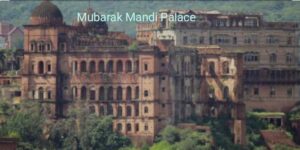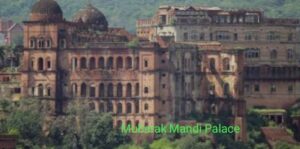Nestled in the heart of Jammu, Mubarak Mandi Palace stands as a testament to the grandeur of the Dogra dynasty. This architectural marvel not only serves as a reminder of the regal past but also as a symbol of the cultural richness of the region. With its stunning blend of Rajasthani, Mughal, and European architectural styles, Mubarak Mandi Palace is a must-visit for anyone interested in history, architecture, and the heritage of Jammu.

1.Mubarak Mandi Palace: Historical Background
The origins of Mubarak Mandi Palace date back to the 19th century, during the reign of the Dogra rulers. The construction of the palace complex was initiated by Maharaja Gulab Singh, the founder of the Dogra dynasty, and continued under his successors. The palace served as the royal residence of the Dogra Maharajas for over 150 years, witnessing numerous historical events that shaped the course of Jammu’s history.
The Dogra rulers used the palace as their main seat of power, where important decisions were made, and grand ceremonies were held. Over the years, the palace expanded into a sprawling complex with multiple courtyards, halls, and royal chambers, each reflecting the opulence and grandeur of the Dogra era.
2. Mubarak Mandi Palace: Architectural Significance
Mubarak Mandi Palace is renowned for its unique architectural style, which is a fusion of Rajasthani, Mughal, and European influences. The palace complex is spread over several acres, with each structure showcasing intricate detailing and grandeur. The blend of different architectural styles gives the palace a distinct character, making it a unique piece of heritage in India.
Key features of the palace include its ornate courtyards, majestic halls, and intricate balconies. The Pink Hall, which once housed the Dogra Art Museum, is particularly noteworthy for its collection of miniature paintings and artifacts. The Royal Courts, where the Maharajas held their durbars (royal assemblies), are also significant for their historical importance and architectural beauty.
The palace’s Sheesh Mahal, adorned with exquisite mirror work, is another highlight. The intricate designs and craftsmanship of this section reflect the luxury and elegance of the Dogra era. The Gol Ghar, a round structure within the palace complex, adds to the architectural diversity of Mubarak Mandi.
3.Palace Layout and Notable Sections
The layout of Mubarak Mandi Palace is a maze of courtyards, halls, and chambers, each with its own unique charm. Some of the most notable sections of the palace include:
– Darbar Hall : This grand hall was the site of many royal ceremonies and gatherings. Its high ceilings, decorated with intricate designs, and the grand chandelier in the center add to the regal atmosphere of the hall. The Darbar Hall is a perfect representation of the palace’s grandeur and historical significance.
– Royal Courts : The Royal Courts served as the administrative center of the Dogra rulers. These courts were where the Maharajas dispensed justice and conducted state affairs. The architecture of the Royal Courts is marked by its grandeur and attention to detail, reflecting the power and authority of the Dogra dynasty.
– Sheesh Mahal : Known for its stunning mirror work, Sheesh Mahal is one of the most beautiful sections of the palace. The walls and ceilings of this section are adorned with thousands of tiny mirrors, creating a dazzling effect when light hits them. Sheesh Mahal is a testament to the luxurious lifestyle of the Dogra rulers.
– Gol Ghar : This unique circular structure within the palace complex is another architectural marvel. The Gol Ghar is believed to have served various purposes over the years, adding to the historical intrigue of the palace.

4.Cultural and Social Importance
Mubarak Mandi Palace was not just a royal residence; it was also a cultural hub where festivals, ceremonies, and social gatherings were held. The palace played a significant role in the cultural life of Jammu, with its halls and courtyards hosting numerous events that brought together the people of the region.
The Dogra rulers were known for their patronage of the arts, and Mubarak Mandi Palace served as a center for cultural activities. From music and dance performances to royal banquets and celebrations, the palace was always abuzz with activity. The palace continues to hold cultural significance today, as efforts are made to preserve and celebrate the Dogra heritage.
5.Restoration and Preservation Efforts
Over the years, Mubarak Mandi Palace has faced the ravages of time and neglect. However, recognizing its historical and cultural importance, efforts have been made to restore and preserve this magnificent palace. The government, along with heritage organizations, has initiated several restoration projects to bring the palace back to its former glory.
The restoration work involves repairing the damaged sections of the palace, preserving its intricate artwork, and ensuring that the original architectural style is maintained. While the restoration process is challenging due to the scale of the palace and the extent of the damage, the efforts are crucial to preserving this important piece of Jammu’s heritage.
Future plans for the palace include transforming it into a major tourist attraction, with facilities for guided tours, exhibitions, and cultural events. The goal is to not only preserve the palace but also to make it a center for learning and appreciation of Dogra culture and history.
6.Tourist Information
Mubarak Mandi Palace is open to visitors throughout the year. The best time to visit the palace is during the cooler months, from October to March, when the weather is pleasant for exploring the outdoor sections of the complex. The palace is open from 10:00 AM to 5:00 PM, and there is a nominal entry fee for visitors.
For those interested in history and architecture, a guided tour of the palace is highly recommended. The guides provide in-depth information about the history, architecture, and significance of each section of the palace, making the visit more enriching. Visitors are also encouraged to explore the nearby attractions, such as the Raghunath Temple and the Bahu Fort, to get a complete experience of Jammu’s heritage.
Conclusion:
Mubarak Mandi Palace is more than just a historical monument; it is a symbol of the rich cultural heritage of Jammu. The palace’s architectural grandeur, historical significance, and cultural importance make it a must-visit destination for anyone exploring the region. As restoration efforts continue, the palace is set to become an even more prominent landmark, preserving the legacy of the Dogra dynasty for future generations.
FAQ:
1.Who built Mubarak Mandi Palace?
2.Who was Raja Dhruv Dev of Jammu?
3.What is the name of the palace in Kashmir?
4.Who was the first Dogra ruler of Jammu and Kashmir?
5.Mubarak Mandi Palace location
6.Mubarak mandi palace photos
7.Mubarak mandi palace wikipedia

